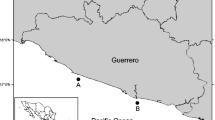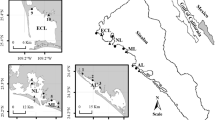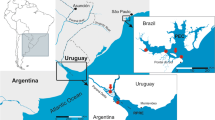Abstract
The coastal plain of Rio Grande do Sul is considered to be a Se-deficient region in terms of its population dietary habit, making it the focus of this study. Selenium dietary deficiency is a concern when we consider its potential critical health effects on the local population. Therefore, this study contributes new information on the levels of Se in several species of marine and freshwater fish in the region of the Patos-Mirim Lagoon system, coupled with a comparative analysis of the metalloid contents between both fish groups. The Se contents in the fish species ranged from 88 ± 13 to 688 ± 19 μg.kg−1. The average Se concentration in the muscle tissue of the freshwater species (251 ± 96 μg kg−1) was significantly lower than that of the marine species (412 ± 143 μg kg−1). Likewise, no evidence of Se biomagnification was found among the fish from both the marine and freshwater environments, suggesting the absence of trophic transfer of Se. We note that to ensure that the RDA (Recommended Daily Allowance, 55 μg day−1) of Se dietary intake for adults is met, at least 134 g of freshwater or 82 g of marine fish fillet could be incorporated into the diet of the population of Rio Grande do Sul. According to target hazard quotients (THQ) and the permissible safety limits, consumption of the fish species analyzed is safe for human health.





Similar content being viewed by others
Data Availability
The authors confirm that the data supporting the findings of this study are available within the article.
References
Sele V, Ørnsrud R, Sloth JJ et al (2018) Selenium and selenium species in feeds and muscle tissue of Atlantic salmon. J Trace Elem Med Biol 47:124–133. https://doi.org/10.1016/j.jtemb.2018.02.005
Karlson U, Frankenberger WT, Spencer WF (1994) Physicochemical properties of dimethyl selenide and dimethyl diselenide. J Chem Eng Data. https://doi.org/10.1021/je00015a049
Silva ALO da, Barrocas PRG, Jacob S do C, Moreira JC (2005) Dietary intake and health effects of selected toxic elements. Brazilian J Plant Physiol 17:79–93. https://doi.org/10.1590/S1677-04202005000100007
Riaz M, Mehmood KT (2012) Selenium in human health and disease: a review. J Postgrad Med Inst.
Loomba R, Filippini T, Chawla R et al (2020) Exposure to a high selenium environment in Punjab, India: effects on blood chemistry. Sci Total Environ 716:135347. https://doi.org/10.1016/j.scitotenv.2019.135347
Fairweather-Tait SJ, Bao Y, Broadley MR, et al (2011) Selenium in human health and disease. Antioxidants Redox Signal.
Chariot P, Bignani O (2003) Skeletal muscle disorders associated with selenium deficiency in humans. Muscle and Nerve
Al-Kunani AS, Knight R, Haswell SJ, et al (2001) The selenium status of women with a history of recurrent miscarriage. Br J Obstet Gynaecol. https://doi.org/10.1016/S0306-5456(01)00253-4
Sharma VK, McDonald TJ, Sohn M et al (2015) Biogeochemistry of selenium. A review Environ Chem Lett 13:49–58. https://doi.org/10.1007/s10311-014-0487-x
Eswayah AS, Smith TJ, Gardiner PHE (2016) Microbial transformations of selenium species of relevance to bioremediation. Appl Environ Microbiol. https://doi.org/10.1128/AEM.00877-16
Simmons DBD, Wallschläger D (2005) A critical review of the biogeochemistry and ecotoxicology of selenium in lotic and lentic environments. Environ Toxicol Chem. https://doi.org/10.1897/04-176R.1
Fernández-Martínez A, Charlet L (2009) Selenium environmental cycling and bioavailability: a structural chemist point of view. Rev Environ Sci Biotechnol
Violante A, Cozzolino V, Perelomov L et al (2010) Mobility and bioavailability of heavy metals and metalloids in soil environments. J Soil Sci Plant Nutr 10:268–292. https://doi.org/10.4067/S0718-95162010000100005
Fordyce FM (2013) Selenium deficiency and toxicity in the environment. In: Essentials of Medical Geology: Revised Edition
Mirlean N, Seus-Arrache ER, Vlasova O (2018) Selenium deficiency in subtropical littoral pampas: environmental and dietary aspects. Environ Geochem Health 40:543–556. https://doi.org/10.1007/s10653-017-9951-4
Recommended Dietary Allowances (1989). National Academies Press, Washington, D.C. https://doi.org/10.17226/1349
Yadav SK, Singh I, Singh D, Han S Do (2005) Selenium status in soils of northern districts of India. J Environ Manage. https://doi.org/10.1016/j.jenvman.2004.11.013
Yamada H, Kamada A, Usuki M, Yanai J (2009) Total selenium content of agricultural soils in Japan. Soil Sci Plant Nutr. https://doi.org/10.1111/j.1747-0765.2009.00397.x
Nazemi L, Nazmara S, Eshraghyan MR, et al (2012) Selenium status in soil, water and essential crops of Iran. Iran J Environ Heal Sci Eng. https://doi.org/10.1186/1735-2746-9-11
Lemly AD, Smith GJ (1991) Aquatic cycling of selenium: implications for fish and wildlife. US Geol Surv Circ
World Health Organization, WHO (1987) Selenium. Environmental Health Criteria 58.
Bourre JM, Paquotte P (2008) Seafood (wild and farmed) for the elderly: contribution to the dietary intakes of iodine, selenium, DHA and vitamins B12 and D. J Nutr Heal Aging. https://doi.org/10.1007/BF02982617
Lemly AD (1999) Selenium transport and bioaccumulation in aquatic ecosystems: a proposal for water quality criteria based on hydrological units. Ecotoxicol Environ Saf. https://doi.org/10.1006/eesa.1998.1737
Stewart R, Grosell M, Buchwalter D, et al (2010) Bioaccumulation and trophic transfer of selenium. In: Ecological Assessment of Selenium in the Aquatic Environment
Sampaio da Silva D, Lucotte M, Paquet S et al (2013) Inverse mercury and selenium concentration patterns between herbivorous and piscivorous fish in the Tapajos River, Brazilian Amazon. Ecotoxicol Environ Saf 97:17–25. https://doi.org/10.1016/j.ecoenv.2013.06.025
Lino AS, Kasper D, Guida YS et al (2018) Mercury and selenium in fishes from the Tapajós River in the Brazilian Amazon: an evaluation of human exposure. J Trace Elem Med Biol 48:196–201. https://doi.org/10.1016/j.jtemb.2018.04.012
Lemire M, Fillion M, Barbosa F Jr et al (2010) Elevated levels of selenium in the typical diet of Amazonian riverside populations. Sci Total Environ 408:4076–4084. https://doi.org/10.1016/j.scitotenv.2010.05.022
Ambrógi JB, Avegliano RP, Maihara VA (2016) Essential element contents in food groups from the second Brazilian total diet study. J Radioanal Nucl Chem 307:2209–2216. https://doi.org/10.1007/s10967-015-4591-6
Medeiros RJ, dos Santos LMG, Freire AS et al (2012) Determination of inorganic trace elements in edible marine fish from Rio de Janeiro State, Brazil. Food Control 23:535–541. https://doi.org/10.1016/j.foodcont.2011.08.027
Medeiros RJ, dos Santos LMG, Gonçalves JM et al (2014) Comparison of the nutritional and toxicological reference values of trace elements in edible marine fish species consumed by the population in Rio De Janeiro State, Brazil. Toxicol Reports 1:353–359. https://doi.org/10.1016/j.toxrep.2014.06.005
Mirlean N, Ferraz AH, Seus-Arrache ER, et al (2019) Mercury and selenium in the Brazilian subtropical marine products: food composition and safety. J Food Compos Anal 84:. https://doi.org/10.1016/j.jfca.2019.103310
Costa L, Mirlean N (2020) Selenium enrichment in pore water of estuarine sediments subject to salt marsh vegetation bioirrigation (Patos Estuary, Southern Brazil). Bull Environ Contam Toxicol 105:468–473. https://doi.org/10.1007/s00128-020-02978-8
Burns MDM, Garcia AM, Vieira JP, et al (2006) Evidence of habitat fragmentation affecting fish movement between the Patos and Mirim coastal lagoons in southern Brazil. Neotrop Ichthyol. https://doi.org/10.1590/S1679-62252006000100006
Kjerfve B (1994) Coastal lagoons. Elsevier Oceanogr Ser. https://doi.org/10.1016/S0422-9894(08)70006-0
Barros GP de, Marques WC, Kirinus E de P (2014) Influence of the freshwater discharge on the hydrodynamics of Patos Lagoon, Brazil. Int J Geosci. https://doi.org/10.4236/ijg.2014.59080
Seeliger U (2001) The Patos Lagoon Estuary, Brazil. pp 167–183
Hirata FE, Möller Júnior OO, Mata MM (2010) Regime shifts, trends and interannual variations of water level in Mirim Lagoon, southern Brazil. Panam J Aquat Sci
Assumpção CM, Quintela FM, Corrêa F, Loebmann D (2016) The ichthyofauna of limnic systems in quaternary deposits of extreme southern Brazil. Zookeys. https://doi.org/10.3897/zookeys.638.9199
Haimovici M, Cardoso LG (2017) Long-term changes in the fisheries in the Patos Lagoon estuary and adjacent coastal waters in Southern Brazil. Mar Biol Res 13:135–150. https://doi.org/10.1080/17451000.2016.1228978
Ministério do Meio Ambiente, MMA (2008) Orgs. Zamboni, A, Nicolodi JL, Macrodiagnóstico da Zona Costeira e Marinha do Brasil
United States Environmental Protection Agency (USEPA), 2014. Microwave assisted acid digestion of siliceous and organically based matrices. Retrieved January 31, 2022 from the USEPA Home Page. https://www.epa.gov/
Mohammed E, Mohammed T, Mohammed A (2017) Optimization of an acid digestion procedure for the determination of Hg, As, Sb, Pb and Cd in fish muscle tissue. MethodsX 4:513–523. https://doi.org/10.1016/j.mex.2017.11.006
Avegliano RP, Maihara VA, da Silva FF (2015) Development of the food list for a Brazilian Total Diet Study. Food Sci Technol 35:207–212. https://doi.org/10.1590/1678-457X.6279
Instituto Brasileiro de Geografia e Estatistica (IBGE), 2009. Pesquisa de Orçamentos Familiares.2008–2009. Analise do consumo Alimentar Pessoal no Brasil. https://biblioteca.ibge.gov.br/visualizacao/livros/liv50063.pdf Accessed 31 Jan 2022.
Institute of Medicine (2000) Dietary reference intakes for vitamin C, vitamin E, selenium, and carotenoids. National Academy Press, Washington, DC
United States Environmental Protection Agency (USEPA), 2022a. Regional Screening Levels (RSLs) - User's Guide. Retrieved 2022–01–31, from. https://www.epa.gov/risk/regional-screening-levels-rsls-users-guide
Alamdar A, Eqani SAMAS, Hanif N et al (2017) Human exposure to trace metals and arsenic via consumption of fish from river Chenab, Pakistan and associated health risks. Chemosphere 168:1004–1012. https://doi.org/10.1016/j.chemosphere.2016.10.110
Gbogbo F, Arthur-Yartel A, Bondzie JA et al (2018) Risk of heavy metal ingestion from the consumption of two commercially valuable species of fish from the fresh and coastal waters of Ghana. PLoS ONE 13:e0194682. https://doi.org/10.1371/journal.pone.0194682
United States Environmental Protection Agency (USEPA), 2022a. Regional Screening Levels (RSLs) - Equations Retrieved 2022–31–01, from https://www.epa.gov/risk/regional-screening-levels-rsls-equations
United States Environmental Protection Agency (USEPA), 2022b. Regional Screening Levels (RSLs) - Generic Tables Retrieved 2022–31–01, from https://www.epa.gov/risk/regional-screening-levels-rsls-generic-tables
Instituto Brasileiro de Geografia e Estatistica (IBGE), 2009.. Pesquisa de Orçamentos Familiares.2008–2009. Antropometria e estado nutricional de crianças, adolescentes e adultos no Brasil. https://biblioteca.ibge.gov.br/visualizacao/livros/liv45419.pdf Accessed 31 Jan 2022.
Selenium toxicity and its adverse health effects U Tinggi - Reviews in Food and Nutrition Toxicity, 2005
Lemly AD (2007) A procedure for NEPA assessment of selenium hazards associated with mining. Environ Monit Assess. https://doi.org/10.1007/s10661-006-9445-9
Zwolak I, Zaporowska H (2012) Selenium interactions and toxicity: a review. Cell Biol Toxicol 28:31–46. https://doi.org/10.1007/s10565-011-9203-9
Langston WJ, Bryan GW (1984) The relationships between metal speciation in the environment and bioaccumulation in aquatic organisms. Complexation of trace metals in natural waters. Springer, Netherlands, Dordrecht, pp 375–392
Ni IH, Chan SM, Wang WX (2005) Influences of salinity on the biokinetics of Cd, Se, and Zn in the intertidal mudskipper Periophthalmus cantonensis. Chemosphere 61:1607–1617. https://doi.org/10.1016/j.chemosphere.2005.04.090
Lima APS, Sarkis JES, Shihomatsu HM, Müller RCS (2005) Mercury and selenium concentrations in fish samples from Cachoeira do PiriáMunicipality, ParáState, Brazil. Environ Res 97:236–244. https://doi.org/10.1016/j.envres.2004.05.005
Garnero PL, de Bistoni M, los A, Monferran M V. (2020) Trace element concentrations in six fish species from freshwater lentic environments and evaluation of possible health risks according to international standards of consumption. Environ Sci Pollut Res 27:27598–27608. https://doi.org/10.1007/s11356-020-08756-7
LeBlanc KL, Kumkrong P, Mercier PHJ, Mester Z (2018) Selenium analysis in waters. Part 2: Speciation methods. Sci Total Environ 640–641:1635–1651. https://doi.org/10.1016/j.scitotenv.2018.05.394
Dorea JG, Moreira MB, East G, Barbosa AC (1998) Selenium and mercury concentrations in some fish species of the Madeira river, Amazon Basin, Brazil. Biol Trace Elem Res 65:211–220. https://doi.org/10.1007/BF02789097
Seixas T, Moreira I, Siciliano S et al (2014) Mercury and selenium in tropical marine plankton and their trophic successors. Chemosphere 111:32–39. https://doi.org/10.1016/j.chemosphere.2014.03.003
Kehrig HA, Seixas TG, Palermo EA et al (2009) The relationships between mercury and selenium in plankton and fish from a tropical food web. Environ Sci Pollut Res 16:10–24. https://doi.org/10.1007/s11356-008-0038-8
Kehrig HA, Seixas TG, Di Beneditto APM, Malm O (2013) Selenium and mercury in widely consumed seafood from South Atlantic Ocean. Ecotoxicol Environ Saf 93:156–162. https://doi.org/10.1016/j.ecoenv.2013.03.034
Garnero PL, Monferran MV, González GA et al (2018) Assessment of exposure to metals, As and Se in water and sediment of a freshwater reservoir and their bioaccumulation in fish species of different feeding and habitat preferences. Ecotoxicol Environ Saf 163:492–501. https://doi.org/10.1016/j.ecoenv.2018.07.023
Garcia TO, Giarrizzo T (2014) Nível Trófico de Peixes da Costa Brasileira. Biota Amaz 4:130–160. https://doi.org/10.18561/2179-5746/biotaamazonia.v4n2p130-160
Orr PL, Guiguer KR, Russel CK (2006) Food chain transfer of selenium in lentic and lotic habitats of a western Canadian watershed. Ecotoxicol Environ Saf 63:175–188. https://doi.org/10.1016/j.ecoenv.2005.09.004
Funding
This work was supported by the State of Rio Grande do Sul Research Support Foundation (FAPERGS), grant 19/2551–0001757-0.
Author information
Authors and Affiliations
Contributions
All authors contributed to the study conception and design. Material preparation, data collection, and analysis were performed by Alexandre Henrique Ferraz, Larissa Pinheiro Costa, and Elisa Rosa Seus-Arrache. The first draft of the manuscript was written by Alexandre Henrique Ferraz and all authors commented on previous versions of the manuscript. All authors read and approved the final manuscript.
Corresponding author
Ethics declarations
Competing Interests
The authors declare no competing interests.
Additional information
Publisher's Note
Springer Nature remains neutral with regard to jurisdictional claims in published maps and institutional affiliations.
Rights and permissions
About this article
Cite this article
Ferraz, A.H., Costa, L.P., Mirlean, N. et al. Selenium Content in Freshwater and Marine Fish from Southern Brazil Coastal Plain: a Comparative Analysis on Environmental and Dietary Aspects. Biol Trace Elem Res 201, 946–958 (2023). https://doi.org/10.1007/s12011-022-03192-9
Received:
Accepted:
Published:
Issue Date:
DOI: https://doi.org/10.1007/s12011-022-03192-9




